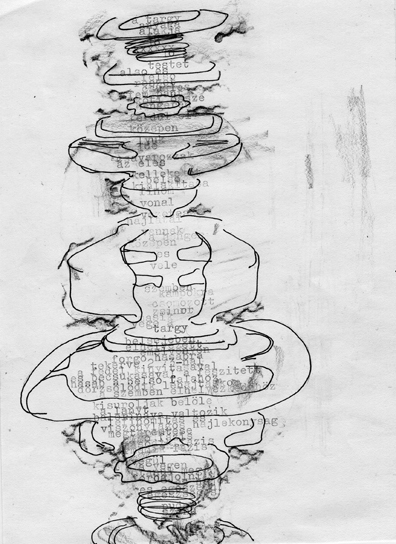“ALL MACHINE” is the overarching title under which Tóth produces a range of works, including not only the visual poems featured here in Asymptote, but also experimental sound works with Molnár Gergely (performed and recorded under the name Hegyfalu), multi-media installations, and a book of more conventional lineated poems, published in Hungary by Magvetö and in Germany by Akademie Schloss Solitude.
“BALLERINA,” the poem that opens the book ALL MACHINE, was a turning point for the poet, and initiated the series of works that would later be grouped under the rubric “all machine.” “BALLERINA” describes a mechanical figure turning on a music box. The careful description of a rotating figure and the mechanism of the music box is ominous as it is increasingly rigid, robotic, and “turns” on domestic violence. Tóth recalled that “BALLERINA” was different than anything she had written before because it seemed to emerge as automatic chunks, as if the poet herself were a rotating, mechanical figure, the language of the poem self-generating. She recalled, “I experienced the text of ‘BALLERINA’ as a machine.”
Throughout Tóth’s ensuing series of poems, texts present coldly technical language that stammers and breaks, infused as it is with human suffering. The long poem “CRANE” describes the cranes in shipping yards used to hoist containers; again, the precise language employed to describe heft and weight, and the sounds of metal scraping, gradually morphs to evoke human trafficking.
Tóth confirmed that, yes, dialysis is a metaphor that she likes because it suggests the creative process as a recirculation and transformation of waste—whether that be the waste of the human body or the waste of social and political systems—into a new, hybrid organism. In a poem such as “ORGAN,” Tóth riffs on the double meaning of organ as musical instrument and organ as body part, as, literally, “that with which one works.” Because of her own experience with recurring illness, the artist is partial to the image of the body connected to the machine; reciprocities of the body and the machine are experiences that inform her work.
Many of the visual poems featured here—such as “BALLERINA” and “CRANE”—have counterparts in the poems on the pages of ALL MACHINE, but Tóth uses phrases from the published poems “with the aim of losing the words.” Tóth dismantles her more conventional readerly poems and inserts “noise” in the form of typewriter riffs, contour drawings, and rubbings.
In some poems, the contour lines are thick, geometric, vaguely architectural, and the blocks of dense text echo architectural building blocks, reinforced by the wide monospacing of a Courier typeface that aligns letters both vertically and horizontally, resembling a grid or a torn screen. In other visual poems, contour lines circle and meander around the text, as if to animate the white space. The drawings may be biomorphic, with the swirls of an ear canal or the anatomy of a throat; in other drawings, the contour lines outline machine parts, nozzles, levers, electrical cords, or the mouthpiece of an instrument.
Among the lines and typed phrases, smudges of black crayon darken the pages as if soiled by careless handling. These smudges are in fact “patterns” of vibration created by placing the pages on top of machines and using black crayon to make rubbings as the machine vibrated. Executed in factories where Tóth has worked, including a meat factory, an automotive factory, and a gas refinery, Tóth’s rubbings are traces of labor, and a means to insert visual “noise” among the written and drawn lines of her poems. While the typed phrases in Tóth’s visual poems are a mix of English, German, and Hungarian, the poet insists that translation is not necessary, that legibility is not the point; words in her poem-drawings shake their signifying function and border on visual stammers, the line spacing often squeezed, the lines tightly stacked, and the pages factory-tuned.

